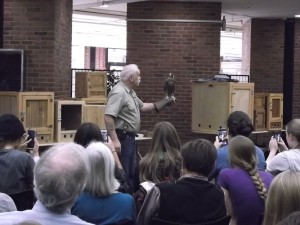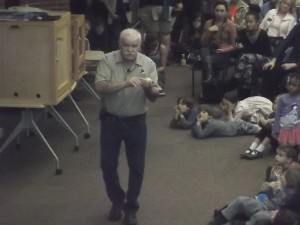To help celebrate Homecoming Weekend (go UMass!), former DFW Conservation Officer Tom Ricardi brought a few tame birds of prey to the Learning Commons in Dubois Library this afternoon. An overflow crowd filled the small space near the banks of computers on the first floor and listened enthralled as he spoke about his work with these magnificent creatures. Although they are now rehabilitated, these particular birds cannot be released back to the wild because they would not survive, due to various injuries they’ve suffered. In contrast, birds ready to release back into the wild are not handled by humans because of the concern that the animals will imprint on people rather than on their own kind. Mr Ricardi noted that even his captive birds are still wild animals and not pets, so he doesn’t name them.
Currently, there are about 30 species of birds on the list of threatened, endangered, or species of special concern in Massachusetts; bird numbers are declining due to a variety of reasons, among them loss of habitat, auto collisions, and even methane gas combustion. Fortunately, Mr Ricardi noted, Massachusetts has been a leader in bird conservation since the 1890s, starting with Boston society ladies Harriet Lawrence Hemenway and Minna B Hall who persuaded their contemporaries to forego wearing feathers as fashion accessories. In fact, the federal Migratory Bird Treaty Act of 1918, which can be considered an outcome of their legislative efforts, is still in effect.
Here are some of the birds Mr Ricardi introduced to us:
Great Horned Owl (Bubo virginianus) – this individual is about twenty years old – it eats mostly mice – though it has excellent eyesight, it relies mainly on hearing to catch prey
Screech Owl (Megascops asio) – second smallest owl species in Massachusetts – this individual is about 14 or 15 years old
Saw-Whet Owl (Aegolius acadicus) – smallest owl species in Massachusetts – its diet is mostly rodents, though its prey varies depending on the time of year
American Kestrel (Falco sparverius) – cavity nester – one field mark is a black stripe under the eye – the Commonwealth is making an effort to bring the birds back by installing nesting boxes – watch for them as you drive on I-91 in the Deerfield area
Peregrine Falcon (Falco peregrinus) – was hit by a plane at Bedford Airfield and one wing was sheared off – the peregrine has huge feet which turn yellow in its second year – females are larger than males
Red-Tailed Hawk (Buteo jamaicensis) – most common soaring hawk – likes to eat chickens and thus has been known as the “chicken hawk” – takes out prey on the ground with its powerful feet – in the bird’s second year, its tail feathers turn the typical rusty red color – it weighs about two and a half pounds and can take out prey half its weight
Harris’s Hawk (Parabuteo unicinctus) – southern species, more common in arid Southwest – has long legs, short wings, and a long tail – it nests in family groups and hunts small mammals cooperatively
At this point, I moved to the stairs and listened as Mr Ricardi described how raptor eggs hatch, but then I had to leave, so I quietly headed out of the building (I took this photo from my position on the stairs).

